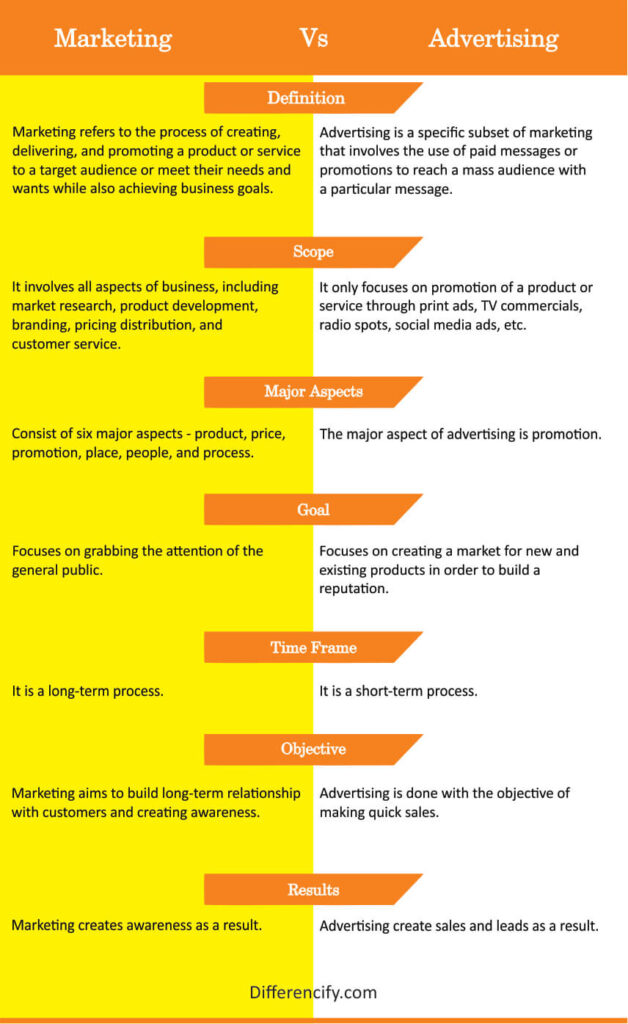The success of any organization is based on marketing and advertising. These two are the only strategies that can help a business grow and retain stability in the market. Marketing is a process that starts with establishing a company’s identity and then building an image for it through activities like branding, PR campaigns, and public relations. Advertising, on the other hand, is about reaching out to prospective customers by communicating with them directly.
Marketing Vs Advertising (Comparison Table)
| Marketing | Advertising |
|---|---|
| Marketing refers to the process of creating, delivering, and promoting a product or service to a target audience in order to meet their needs and wants while also achieving business goals. | Advertising, on the other hand, is a specific subset of marketing that involves the use of paid messages or promotions to reach a mass audience with a particular message. |
| It involves all aspects of business including, market research, product development, branding, pricing, distribution, and customer service. | It only focuses on the promotion of a product or service through print ads, TV commercials, radio spots, newspaper ads, and more. |
| Marketing consists of six major aspects – product, price, promotion, place, people, and process. | The major aspect of advertising is promotion. |
| Marketing focuses on grabbing the attention of the general public. | Advertising focuses on creating a market for new and existing products in order to build a reputation. |
| It is a long-term process. | It is a short-term process. |
| Marketing also aims to build long-term relationships with customers and create awareness | Advertising is mainly done with the objective of making quick sales. |
| Marketing creates awareness as a result. | It creates sales and leads as a result. |
What is Marketing?
Marketing is the process of creating value for a company through the creation and distribution of products or services. It includes the entire process of research, development, promotion, and sales. Marketing is about understanding customer needs and desires and then creating a unique offering that meets those needs. It is a long-term business activity that starts with the discovery of the needs and wants of the consumers and it continues till the wants are satisfied.
Moreover, marketing must take into account the different stages of the product life cycle, which include introductions, growth, maturity, and decline. Each stage presents different challenges and opportunities for companies. For example, during the introductory stage, a company must focus on creating awareness of its product or service.
During the growth stage, a company must focus on building customer loyalty and expanding its customer base. And during the decline stage, a company must focus on reducing costs and maximizing profits. In a nutshell, it involves the process of bringing the right product to the right marketplace for the right people at the right price.
Functions of Marketing
- To Create Demand: Marketing is about creating and then satisfying consumer demand. It starts with an understanding of what consumers want and then creating a product or service that meets those needs.
- To Build Relationships: Marketing is also about building relationships with customers and potential customers. Good marketing fosters a relationship of trust between the company and the customer.
- To Communicate Value: Marketing communications must be clear and concise, conveying the value of the product or service to the customer. The best marketing campaigns are those that make it easy for consumers to understand what they are getting for their money.
- To Create Loyalty: Finally, marketing must generate loyalty among customers. Customers who are satisfied with a product or service are more likely to continue doing business with that company in the future.
What is Advertising?
Advertising, on the other hand, is a specific type of marketing communication that uses various media channels, such as television, radio, print, online, or outdoor advertising, to promote a product or service to potential customers. While advertising can be an effective way to promote a product or service, it is only one piece of the marketing puzzle.
Advertising is an expensive marketing process. It is a technique through which a single message can be reached hundreds of people within a few seconds. Moreover, advertising is just one way to create awareness. Publicity, word-of-mouth, and other marketing activities can also be used to generate interest in a product or service.
Salient Features of Advertising
The five salient features of advertising are:
- Identifies a Target Audience: Advertising must identify the target audience that is most likely to be interested in the product or service being advertised.
- Creates Awareness: Advertising must create awareness of the product or service being advertised.
- Persuades the Target Audience: Advertising must persuade the target audience to purchase the product or service being advertised.
- Generates leads: Advertising must generate leads for salespeople to follow up on.
- Closes Sales: Advertising must close sales and get customers to purchase the product or service being advertised.
Key Differences Between Marketing And Advertising
While comparing marketing vs advertising, here we have included some of the key differences between them.
- What is It? – Marketing is about creating a need or want for a product or service, while advertising is about promoting a specific product or service to meet that need or want.
- Cost and Budgeting: Marketing involves a range of activities that may require a significant investment of time and resources, such as market research, product development, and customer service. Advertising, on the other hand, typically involves a direct cost for creating and distributing messages.
- Metrics and Measurement: Marketing success is typically measured by a range of metrics, such as customer satisfaction, customer retention, and market share. Advertising, on the other hand, is often measured by metrics such as reach, frequency, and conversion rates.
The following table exactly shows how both marketing and advertising differ from one another.

Types of Marketing
While there are many different types of marketing, here we have mentioned 5 of the most common types of marketing used in today’s age.
- Content Marketing – It involves creating and distributing valuable content to attract and engage a target audience.
- Social Media Marketing – Social media marketing implies promoting a product or service on social media platforms such as Facebook, Instagram, Twitter, and LinkedIn.
- Email Marketing – This type of marketing involves communicating with customers and prospects via email to promote a product or service or build relationships.
- Influencer Marketing – Influencer marketing is all about partnering with influential people in a specific niche or industry to promote a product or service to their audience.
- Event Marketing – It implies promoting a product or service through sponsored events, such as trade shows, conferences, and seminars.
Types of Advertising
- Display Advertising – Display advertising uses visual ads, such as banners and pop-ups, to promote a product or service on websites or mobile apps.
- Video Advertising – This implies running ads in video content on platforms such as YouTube or social media channels.
- Search Advertising – Search advertising involves placing ads in search engine results pages to promote a product or service to people searching for related keywords.
- Native Advertising – Native advertising is all about creating ads that blend in with the form and function of the platform they are displayed on, such as sponsored content on news websites or social media platforms.
Which One is More Effective and Better for Your Business?
The effectiveness of marketing or advertising depends on the nature and goals of the business. Marketing is more effective for long-term growth, awareness, and building relationships with customers, as it involves understanding customer needs and preferences, creating a brand image, and developing a comprehensive strategy to promote a product or service.
On the other hand, advertising is more effective for short-term goals, such as generating sales or promoting products or services. Moreover, advertising also typically involves a direct cost for creating and distributing messages, and its effectiveness can be measured by metrics such as reach, frequency, and conversion rates.
In general, a combination of marketing and advertising strategies can be the most effective approach for businesses. Marketing provides the foundation for building a brand and establishing a long-term relationship with customers, while advertising can be used to drive short-term sales or promote new products or services. By combining both approaches, businesses can create a comprehensive strategy that addresses both short-term and long-term goals.
Similarities
- The major purpose of both marketing and advertising is to increase leads and sales.
- Both are done with the intent of promoting the product.
- Both of them explain the value of the product or service to the target audience.
Conclusion
Thus we have seen that there are some key differences between marketing and advertising. Advertising is just one element of the marketing mix, and it is focused on creating quick sales and interest in a product or service. Marketing, on the other hand, is a broader term that encompasses all activities involved in getting a product or service to market, including research, development, branding, pricing, distribution, and more.
Both marketing and advertising are important for businesses of all sizes. Which one you prioritize will depend on your business goals and objectives.




7 Comments